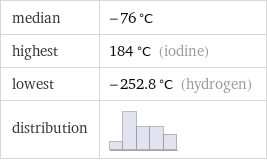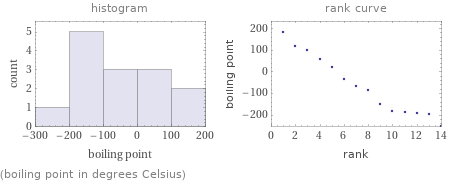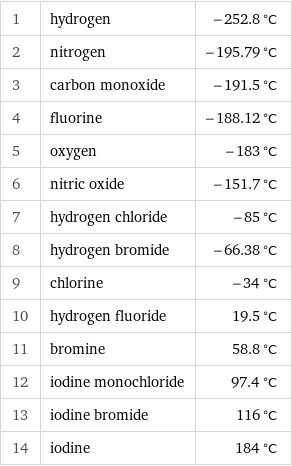Input interpretation

diatomic molecules | boiling point
Summary

median | -76 °C highest | 184 °C (iodine) lowest | -252.8 °C (hydrogen) distribution |
Distribution plots

(boiling point in degrees Celsius)
Boiling point rankings

1 | hydrogen | -252.8 °C 2 | nitrogen | -195.79 °C 3 | carbon monoxide | -191.5 °C 4 | fluorine | -188.12 °C 5 | oxygen | -183 °C 6 | nitric oxide | -151.7 °C 7 | hydrogen chloride | -85 °C 8 | hydrogen bromide | -66.38 °C 9 | chlorine | -34 °C 10 | hydrogen fluoride | 19.5 °C 11 | bromine | 58.8 °C 12 | iodine monochloride | 97.4 °C 13 | iodine bromide | 116 °C 14 | iodine | 184 °C
Unit conversions for median boiling point -76 °C

197 K (kelvins)

-104 °F (degrees Fahrenheit)

355 °R (degrees Rankine)

-61 °Ré (degrees Réaumur)

-32 °Rø (degrees Rømer)
Comparison for median boiling point -76 °C

2 °C above boiling point of dry ice-acetone slurry (-78 °C)

3 °C above sublimation temperature of dry ice (carbon dioxide) (194.6 K)

19 °C above coldest recorded temperature on Earth (-94.7 °C)
Corresponding quantities

Thermodynamic energy E from E = kT: | 17 meV (millielectronvolts)

Blackbody energy flux Φ from Φ = σT^4: | 86 W/m^2 (watts per square meter)

Approximate luminous exitance from a planar blackbody radiator perpendicular to its surface: | 6.6×10^-36 lx (lux)